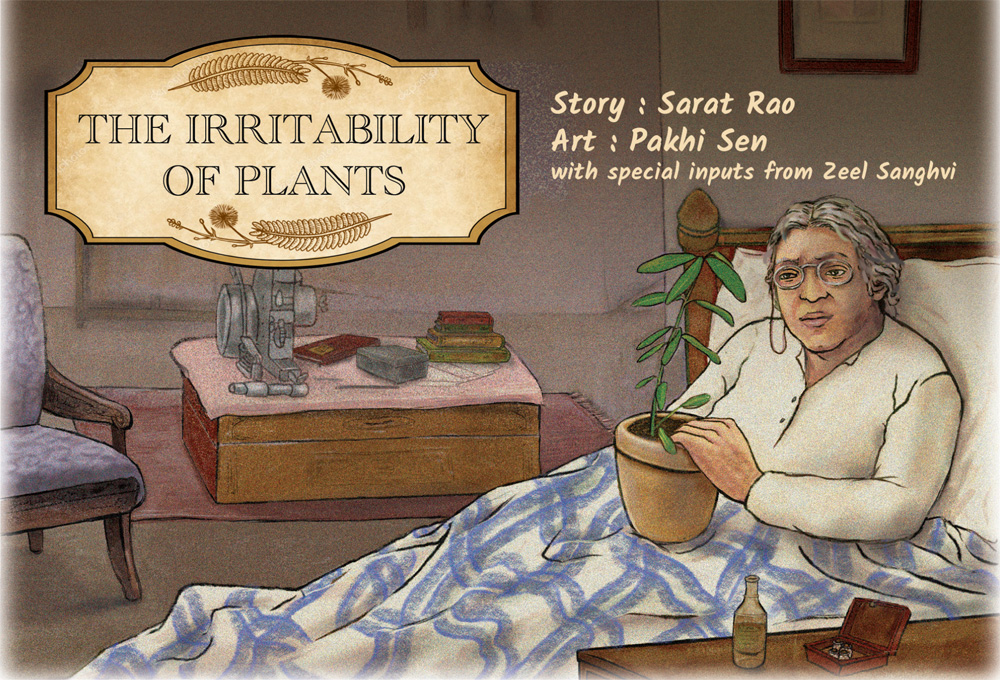
Vol 1 Issue 2 | July-September 2021
The Irritability of Plants
Story by Sarat Talluri Rao | Art by Pakhi Sen with inputs from Zeel Sanghvi
Plants. Ugh. Who cares about plants? Ghas-phus. Diets.
These were some of the thoughts I had about plants as a teenager. However, I was a sci-fi enthusiast and that meant being a science enthusiast. And sometime in high school I came across the applications of the Fibonacci series in nature. That changed everything. The fact that many shapes in nature follow the Fibonacci spiral was quite mind-expanding. Petals on some flowers are arranged according to the Fibonacci series of 1, 1, 2, 3, 5, 8… And this is to optimise the use of sunlight so as not to encroach upon any other petal. I found this fascinating!
It was impossible after that to see plants as dull life-less food. They were the opposite – life-giving, life-enriching life forms.
Here’s a great visual proof for the existence of this pattern:
https://www.youtube.com/watch?v=_GkxCIW46to
In college I ended up learning a lot about everything except my subjects. By then I had also developed a firm aversion to the very notion of subjects. It became apparent to me that nothing existed in a silo. I naturally gravitated towards inter-disciplinary fields like the history of science and mathematics. That was a veritable universe that wasn’t taught at school. In this lifelong quest, I’ve been lucky to come across some spectacular works and ideas. My interest in plants was still intellectual. One such work of beauty was Ernst Heckle’s Die Kunstformen der Natur (The Art-forms of Nature). I began to see plants as manifestations of beauty. I hope you see it that way as well. Enjoy!
https://commons.wikimedia.org/wiki/Kunstformen_der_Natur
At some point I came across an article about the genetics of rice, and learnt that rice has more than twice as many genes as humans. How a gene works is pretty mind-blowing. Here’s a great animated series called Stated Clearly:
https://www.youtube.com/watch?v=5MQdXjRPHmQ
Humans have about 20,000 genes. Why does rice have so many more? This, I realised, is a human-ego-centric question. It made me step out of myself and my species and see how all life evolved and is so deeply inter-connected. In his ground-breaking work Sapiens, Yuval Noah Harari suggests that another way to look at the agricultural revolution is that rice and wheat colonised humans.
Hmmmmm.
Just because we cannot speak with them doesn’t mean plants have nothing to say. As we saw in the Fibonacci spirals, they speak to us in the more universal language of mathematics. But of course there are other ways to communicate. Jagadish Chandra Bose had the vision to raise the question of plant sensitivity. For after all what is communication at its core? Response to a stimulus. And with painstaking experiment after experiment that is what he established.
Would you like to hear music composed by plants?
The podcast Twenty Thousand Hertz (https://rb.gy/2b9leg) explores how plants create and feel vibrations. A musician friend who’s also a gardener shared this with me.
My school in Kolkata was on Acharya Jagadish Chandra Bose Road. Until a few months ago that was all I knew about him. Somehow, I had overlooked his amazing life and achievements. I knew a lot more of the other Bose. Satyendranath Bose. Also an amazing mind. Einstein published a paper with his own name second, giving birth to Bose-Einstein Statistics. And when the Higgs boson was discovered, Bose’s name (which is where the word ‘boson’ comes from) appeared in my consciousness again. So, when I got a chance to conceive a story about JC Bose, I gladly did so.
The thing about being a visionary is that you see far ahead of others. Thankfully Plant Neurobiology is a proper branch of study. Here’s a wonderful TED Talk (https://rb.gy/bukhya) on How Trees Talk to each other! Watching this totally made me view the world in a whole new light. I am part of an ecosystem. A very robust ecosystem that can handle shocks. But for how long? If plants are communicating with each other, it makes you wonder if we could join in this chat room of sorts. What would we learn about the planet? Our Mothership.
The effervescent mycologist Paul Stamets used the term “earth’s natural internet” for an aspect of this plant communication. Here’s a link to his stimulating documentary Fantastic Fungi!
https://fantasticfungi.com/
I vividly recall being mesmerised by certain moments in James Cameron’s epic science-fiction drama Avatar. That inspired me to write a sci-fi story about an asteroid that brings with it a seed of an alien plant. One that slowly creates a dependency and slowly takes over an ecosystem. It was fun to conceive of an extra-terrestrial without tentacles or with uber-cool space-ships. Science fiction to me is just a careful exploration of an idea. Starting off with a simple ‘what if’ and launching into a deeper voyage involving questions of consciousness and existence.
My interest in sci-fi was another reason why I was attracted to the persona of JC Bose. The fact that he was a pioneer in science-fiction writing. Here’s a well-researched article about exactly this. It also has a link to JC Bose’s short story about a cyclone and hair oil.
https://archive.factordaily.com/jc-bose-science-fiction-new-worlds-weekly/
Keep learning!

